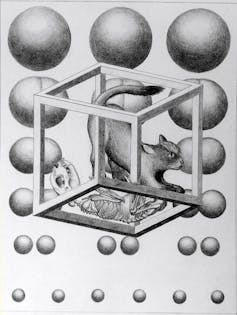Quantum teleportation has been in the news before but last week Japanese and Australian scientists went one better, managing to teleport every physicist’s favourite feline: Schrödinger’s cat.
Before you call the RSPCA, let me assure you that no cats were harmed in the course of this experiment: Schrödinger’s cat is the name of a thought experiment bearing the name of its creator: German physicist Erwin Schrödinger.
Schrödinger suggested that quantum mechanics allows objects to simultaneously possess two values of the same property, a seemingly paradoxical conclusion.
Schrödinger’s cat – wanted dead and alive
Schrödinger showed that it’s not difficult, in principle, to produce a cat which simultaneously has the properties of being both alive and being dead.
More than 75 years later there is still a vigorous debate among physicists and philosophers as to whether, and how, this paradox can be resolved.
In practice, Schrödinger’s paradox is not so easy to implement with real cats (and attempts would no doubt be frowned upon by ethics committees); but it can be done with light, and in this case with bells on – the “cat” has been teleported.
A possible impossibility?
Why is quantum teleportation such a big deal? Two reasons:
1) It should be impossible.
2) It is one of the first hurdles on the road to the exciting new world of quantum information technology.
Let’s think about how teleportation is supposed to work in classical science-fiction.
You take a detailed reading of the state of some object (Captain Kirk, for example), and use this data to recreate him alive and well in the new location.
But with quantum objects, it’s just not possible to take this detailed reading in the first place – the uncertainty principle of quantum mechanics won’t let you.
Further craziness
The uncertainty principle says the more detail you can obtain about some aspect of a quantum object (e.g. its position) the less you can know about a “complementary” aspect of the object (e.g. its speed).
This principle was discovered in the 1920s by Werner Heisenberg, and led to the apocryphal story of the policeman who pulled young Werner up by the side of the road.
The policeman asked: “Do you know how fast you were going?”, to which Heisenberg replied: “No officer, but I do know exactly where I am!”.
You can see the problem: we can’t measure a quantum object to find out everything about it – the uncertainty principle forces us to pick and choose.
So, how can we have any hope of teleporting the object elsewhere?

A sneaky solution - entanglement
The answer to this problem was found in the 1990s, and is based on another strange property of quantum objects: entanglement.
Hold on to your hats/cats, folks: this is where things get a bit gnarly.
Entanglement allows the properties of any two quantum objects to be closely correlated, without these properties having definite values (a concept which greatly perplexed Einstein).
Think of it this way: say you could take two “entangled” quantum particles to opposite ends of the universe. If you were to do something to one of those particles, the other particle (at the opposite end of the universe) would appear to react instantly.
This suggests that entangled objects are somehow still connected, despite the distance separating them.
Freaky …
So let’s suppose one physicist, Alice, wants to teleport a quantum object (a spinning electron or a photon of light, for example) to her friend, Bob.
To do so, she doesn’t just send a stream of data to Bob – remember, she doesn’t know and cannot know everything about the object.
Instead, Alice and Bob share something besides data – they each have one member of a pair of entangled quantum objects, that have been especially prepared beforehand.
Alice now lets the object that she wants to teleport interact with her half of the entangled pair, so that their properties become correlated.
She then measures a property of her object and and a property of the entangled member of the pair, and sends the measurement data to Bob.
This data isn’t enough, on its own, for Bob to reconstruct the quantum object at his end.
But, remember: Bob’s half of the entangled pair is correlated with Alice’s half, which in turn is correlated with the object to be teleported.
It turns out that Bob can use this correlation, in conjunction with the measurement data, to turn his entangled member (!) into a perfect copy of the original object, even though neither he nor Alice knows its complete description.
Problem solved.
Letting the cat out of the bag
Teleportation has been successfully achieved in the laboratory for more than a decade now, but only of very simple quantum objects; too simple for any applications of interest.
To be able to, for example, have a distributed quantum computer network – a “quantum internet” capable of performing such feats as cracking open cryptographic codes in minutes that would take a classical network millennia – one must be able to teleport complicated quantum objects.
This recent feat of teleporting Schrödinger’s cat is a breakthrough because this is precisely what has been done.
So does this mean we now have the ability to teleport Captain Kirk or, for that matter, a real cat?
In short: no. For the moment, we’ll have to be satisfied with theoretical quantum cats.

